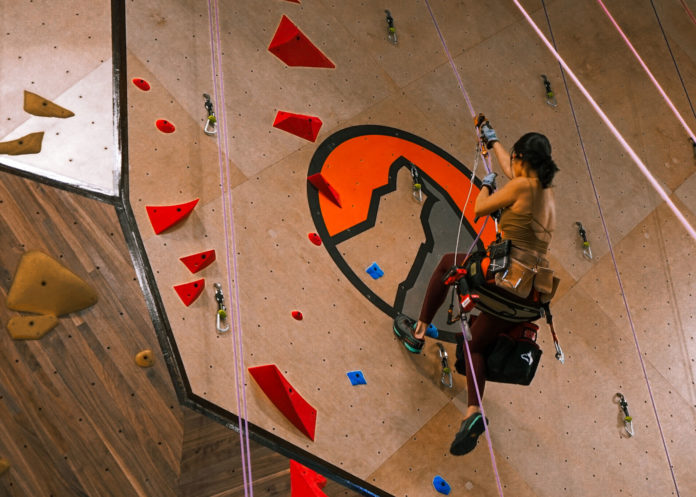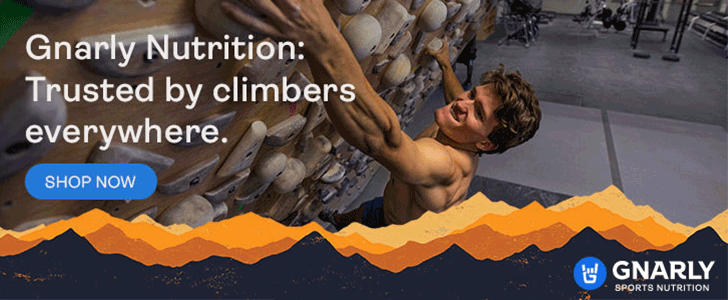Behind the Wrench…is an ongoing series that interviews the “rock stars” of the climbing industry: the routesetters at the gyms. In this installment, we’re talking to Holly Chen. Originally from Taipei, Taiwan, Chen started climbing in Santa Cruz, California, and became enveloped in the routesetting scene after relocating to Colorado. Chen eventually became a routesetter at the Boulder Rock Club and both Übergrippen locations, but her contributions to the industry also extend into journalism and marketing—particularly for Sharp End Publishing and the American Alpine Club. Her writing can also be found in Climbing and Gym Climber. But most noteworthy from a routesetting perspective is that Chen’s story does not follow the typical introductory path; she showed up at a routesetting tryout with zero routesetting experience. Such a unique foundation for a routesetting career gives Chen a fascinating perspective on many aspects of the industry, from mentorship to accessibility.
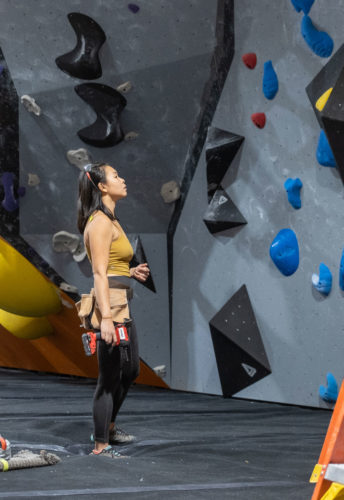
Name: Holly Chen
Location: Boulder, Colorado
BURGMAN: Tell me the full story—or backstory—of you becoming a routesetter without any prior experience.
CHEN: Prior to falling into climbing, I had no real experience in the athletics or sports world, outside of going on day hikes and things like that. After I graduated college, I was kind of in a slump and I didn’t really know where to go—and that’s when I found climbing. At the point of the routesetters’ tryout, I had been climbing for a little under three years; I didn’t climb very hard—probably V3 and 5.11+ grade range. So, I showed up at the Boulder Rock Club, told the head routesetter there [Brent Ng] that I didn’t have any setting experience but I wanted to learn.
Brent taught me how to use a drill on the spot. After a while, I got the hang of it. It’s a little different from how I know a lot of my peers started, which is a routesetting team noticing that you are a strong climber and inviting you to set.
Of all the different aspects of the industry, what was it about routesetting that appealed to you so much?
At first, the appeal was purely based on seeing that the routesetters were usually the strongest climbers of the bunch in a community. So, of course, I wanted to be a stronger climber, and it seemed like routesetting and strong climbing were somewhat related.
As I got to know routesetting more, and especially as I moved from a small climbing community of Santa Cruz into Boulder and Denver, Colorado, where there’s a huge climbing community, I started to see it as an expression—routesetting is essentially storytelling on a wall, storytelling through movement. And when your gym has the budget to choose certain holds and features, it’s actual visual storytelling. When people come in, it’s a little like a museum. They look at certain pieces on the wall and think, ‘Wow, that one looks really fun.’ So, it kind of changed into a different kind of appeal, where it was less connected to how hard you’re going to climb and more connected to how I can engage with climbing as a form of expression.
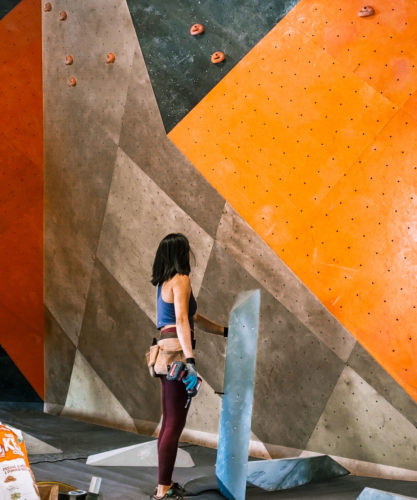
As you were learning the craft basically from scratch, what were some key takeaways?
Brent—the head routesetter at the Boulder Rock Club—focuses a lot on function and flow. He says a lot of new routesetters will fall into the trap of seeing a cool move on Instagram or seeing a cool move at a competition and trying to set it up. Brent says that can be great, but there’s a time and a place for it. If your gym has to have really dense walls because the space is small, or if a gym’s clientele is not necessarily geared to younger comp climbers, some of that might be inappropriate. So, Brent says you should focus on the function of the climb first and foremost. I still carry that with me today.
It’s cool to play with comp moves, it’s cool to experiment with different styles and something that you might not have set before, but when it comes down to it, routesetting is still a job and there’s a customer base that you’re trying to appeal to. Function and productivity of the route are the most important part, and you have to remember what your clientele needs rather than what you want.
Right—I often say routesetters are kind of like chefs, mixing a bit of artistry into something that ultimately has to please customers in a very basic and utilitarian way.
Exactly, and another thing that I keep in mind a lot that has been taught and drilled into me from the Ubergrippen setting crew is inclusivity of your route or boulder. I don’t believe that every bouldering route needs to be accessible by every body type, but a majority of the climbs should be accessible to kids, to older people who are missing the flexibility element, or to girls that don’t have the same type of shoulder strength when they start off climbing. That’s something that I focus on a lot as well: How do we make sure there’s a challenge at the gym for everyone, not just every hard move being a super wide-spanning gaston.
The accessibility and inclusivity topic can be relevant to gender differences too. Would you speak about what it has been like navigating as a female setter in what is largely a male-dominated industry?
All of my mentors in the climbing world—not setting, just climbing, in general—have been men. Some of them have been my age, some of them have been somewhat older. Basically, it was my male friends who taught me how to climb outside, and a lot of the time, when I have questions, I still go to male mentors—who I trust a whole lot. And, as I dive into the sport more and start to meet strong female climbers or strong female setters, or even just make more female friends, in general, I started to notice what I’m lacking in mentorship from people that are the same gender or identify as a female. And that is being able to express something without explaining, and the lack of needing to feel like I have to prove myself to belong. Especially with an all-male routesetting team, navigating that world as kind of a minority in gender means higher visibility. Higher visibility means your mistakes are critiqued more; your mistakes are noticed more. When you fall short, in terms of strength or power, they are a little more apparent because you are different from the rest of the team. And in a personal way—it’s almost like my own dialogue in my head—this often results in negative self-talk, meaning I feel extra hard on myself…I can’t do a certain move because my shoulders just aren’t as strong, or I don’t have as much pulling power and can’t generate the way that my male counterparts can. Negative self-talk means all logic goes out the window. I focus on gender, and I forget that experience matters too. How strong would I be if I had the same years of experience as my male counterparts?
All that heightened visibility kind of takes a toll on you after a while. I went to Louie Anderson’s Setter Showdown and it was a relief because a third of the setters there were ladies, and being able to talk to them about the things I was struggling with—and having them understand immediately, without me having to explain more—was something that I didn’t realize I was missing until I was in that environment. Now I can’t stop thinking about it.
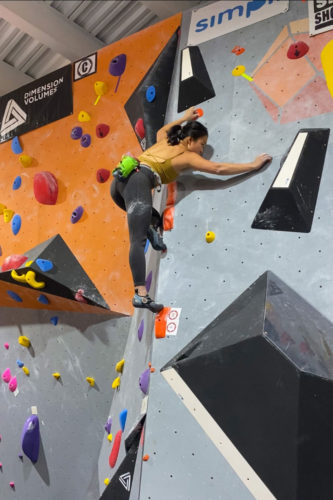
It sounds like one way to improve as an industry is to have additional large, multi-regional gatherings like the Setter Showdown.
I think [last year’s] Setter Showdown was a wonderful way to bring people together and talk about everyone’s different experiences. But, the Setter Showdown is kind of like a professional development type of event; it doesn’t happen very often and it doesn’t mean that everyone who wants to attend can attend. There are financial limitations, there are travel limitations, people might not be able to take time off work. I think a big change needs to come from head routesetters and gyms. The Setter Showdown is a small component in a big change.
The industry probably wasn’t intentional about creating gender disparity, but I think the people who are in positions of power or authority in the industry need to be intentional about changing that disparity or reversing it. And, on a commercial routesetting level, this comes from head routesetters. This means even if a job requirement lists ‘Must climb 5.13/V8 to be a setter,’ it means maybe [the head routesetters] need to take a step back from that and do what Brent did for me at Boulder Rock Club…which is take on someone who isn’t a super strong climber but who has passion and good understanding of movement. You don’t need to be able to climb V8 to understand the movement that is in a V8. If the industry is going to be intentional about changing this gender disparity and making the career path a little more equitable to female climbers, head routesetters might need to take a step back and think that even if someone might not be able to climb the grade on the job requirement, that person in ten years or five years or three years might be the biggest asset on the team.
In terms of change coming from the gyms, what are some specific qualities of a good head routesetter?
A good head setter needs to be able to give constructive feedback really well. If a head setter can deliver constructive feedback well, in terms of why a climb is good or wrong for the customer base, that’s one of the fastest ways that a newer setter can improve and understand commercial routesetting for what it is. Sometimes the feedback will be straightforward, other times it will have to be bubble-wrapped a bit so people’s feelings don’t get hurt.
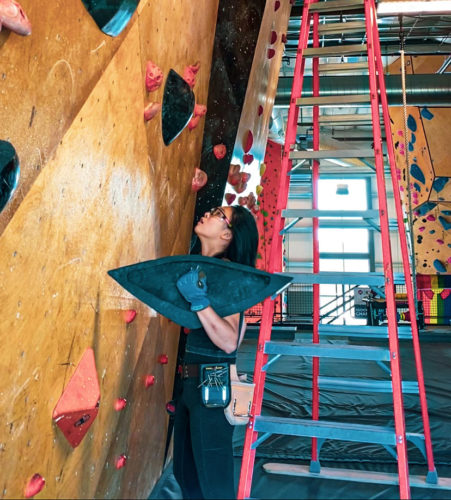
Let’s break it down further: What areas of the industry are headed in a positive direction, and what areas of the industry are lagging behind or even failing the positive advancement of the routesetting craft and career?
The industry is aided by people like Louie Anderson who are looking at the next generation of setters and the next generation of underrepresented setters. And there are other organizations that are doing the same thing, such as Kai Lightner’s Climbing for Change nonprofit. They specifically designed a scholarship for BIPOC climbers to get education in routesetting. And if you look at Scarpa’s mentorship program that was put out recently, they’re also interested in getting underrepresented climbers into positions where they might succeed in the future.
However, with all of that—that’s great—the underlying issue comes back to equitable access. If you look at the USAC Setting certifications: how on top of it do you need to be to get into one of those clinics? People have been trying for years and they can’t get in. Or, every time a new clinic comes up, it’s halfway across the country. So, that means with this lack of mentorship and lack of—even if people have the financial means and the time to get into the clinics—sometimes there’s just not enough spots for the amount of setters who want to come into the industry. With climbing gyms, right now we’re in a giant boom. That means that the demand for good setting talent is on the rise, and there aren’t enough experienced setters to meet this demand…yet. Good, experienced head routesetters are starting to bounce from gym to gym—I’m seeing this where someone moves from out of state, and three months later they’re gone because another gym gave them a better offer. And a lot of gyms that are newer are left with a bare-bones setting crew that cannot keep up with demand.
So, all of this comes back to essentially providing more educational opportunities to mentor setters, whether that’s commercial setting or competition setting. It’s really hard to get into clinics or move up the ranks. Some people higher up in the ranks tell me it’s political and if you want to move up, you have to find and know the right people. That makes me feel like this industry is kind of gatekeeping and keeping specific people out and being very selective about the people they let in…which means this will not be a viable career path or a long-term career path for a lot of people. If you want a family, you need financial stability. Outside of being a head routesetter at a commercial gym…setting is not going to give you financial stability.
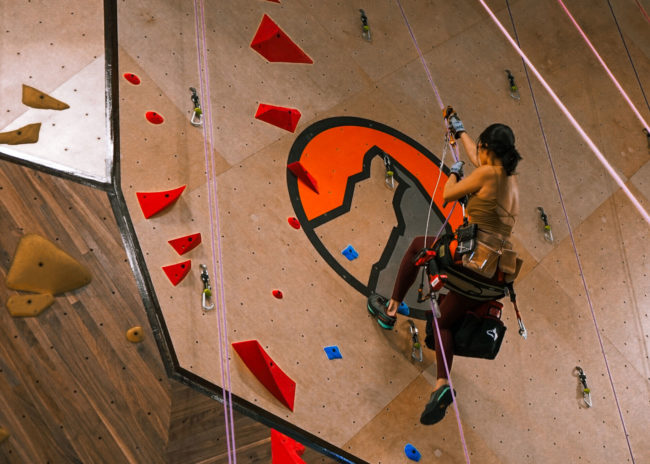
When you mention coming into the industry with the intention of changing it, you certainly have a lot of tools—you’re a climber, a routesetter, and a journalist. How do these all intersect at your stated goal?
A lot of the change feels currently like a pipe dream—it doesn’t feel possible, and that’s something that I struggle with on an everyday basis. Every change that I want to see in the industry that I think should happen doesn’t feel possible for me to make…which means, on that level, I can try to amplify the voices of people that are inflicting this change—for example, I interviewed a lot of super strong lady crushers at the Setter Showdown with the intention of telling their story; they are further along in their career path, they know a lot more than I do, and they already have stuff in the works. If they’re the people that are going to kick off this change and I’m a little behind, I’m OK with that. If I can amplify their voices, great. But if not, at least I’m on this train to creating change and I’m seeing what’s going on and I’m imparting that knowledge onto someone I might potentially mentor down the line.
With how I want to create change, best-case scenario, I want to create some sort of academy where people can learn commercial routesetting—like a trade school, that’s not gatekeeping and not selective about who is coming in and out. When it comes to commercial routesetting, the crux is that people aren’t getting the right resources to create the right products to keep people in climbing. Routesetting is a skilled labor profession and it should be treated like one.

John Burgman is the author of High Drama, a book that chronicles the history of American competition climbing. He is a Fulbright journalism grant recipient and a former magazine editor. He holds a master’s degree from New York University and bachelor’s degree from Miami University. In addition to writing, he coaches a youth bouldering team. Follow him on Twitter @John_Burgman and Instagram @jbclimbs. Read our interview Meet John Burgman, U.S. Comp Climbing’s Top Journalist.




